Key takeaways:
- Remote work success requires a balance between productivity and personal well-being, achieved through defined work hours and a dedicated workspace.
- Effective communication, including regular check-ins and using diverse tools, fosters team alignment and strengthens connections.
- Establishing a clutter-free workspace and utilizing natural light can enhance focus and productivity in a remote setting.
- Continuous improvement through feedback and self-reflection is vital for personal growth and fostering collaborative innovation.
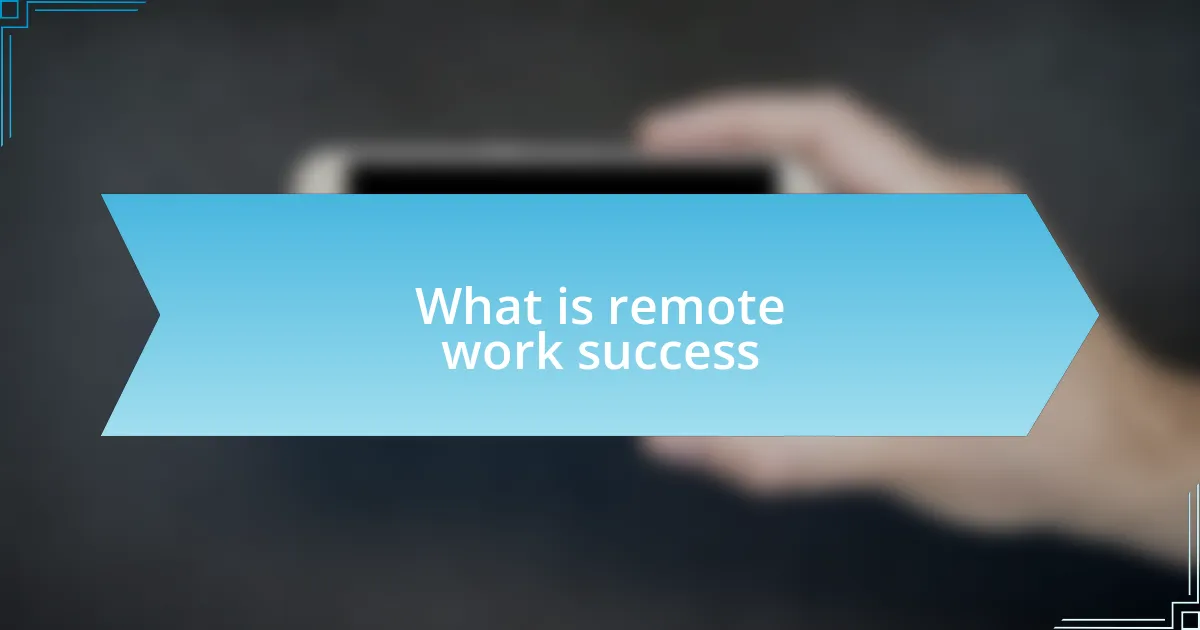
What is remote work success
Remote work success hinges on a few key factors, but for me, it has always been about balance. I vividly remember the early days of working from home, where I struggled to separate my work life from personal life. Finding that equilibrium transformed my experience, allowing me to thrive professionally while still enjoying my personal time.
A great indicator of remote work success is when you can maintain productivity without compromising your well-being. Personally, I’ve found that setting specific work hours and creating a dedicated workspace made a significant difference. It’s like flipping a switch—within those hours, I’m all in, and I can truly recharge once I clock out.
Additionally, effective communication plays a critical role in remote work success. I recall a time when a small misunderstanding with a team member derailed a project. It taught me the value of clarity and consistent check-ins. Have you faced similar challenges? Open dialogue not only strengthens teamwork but also reinforces a sense of community, which is vital when we’re miles apart.
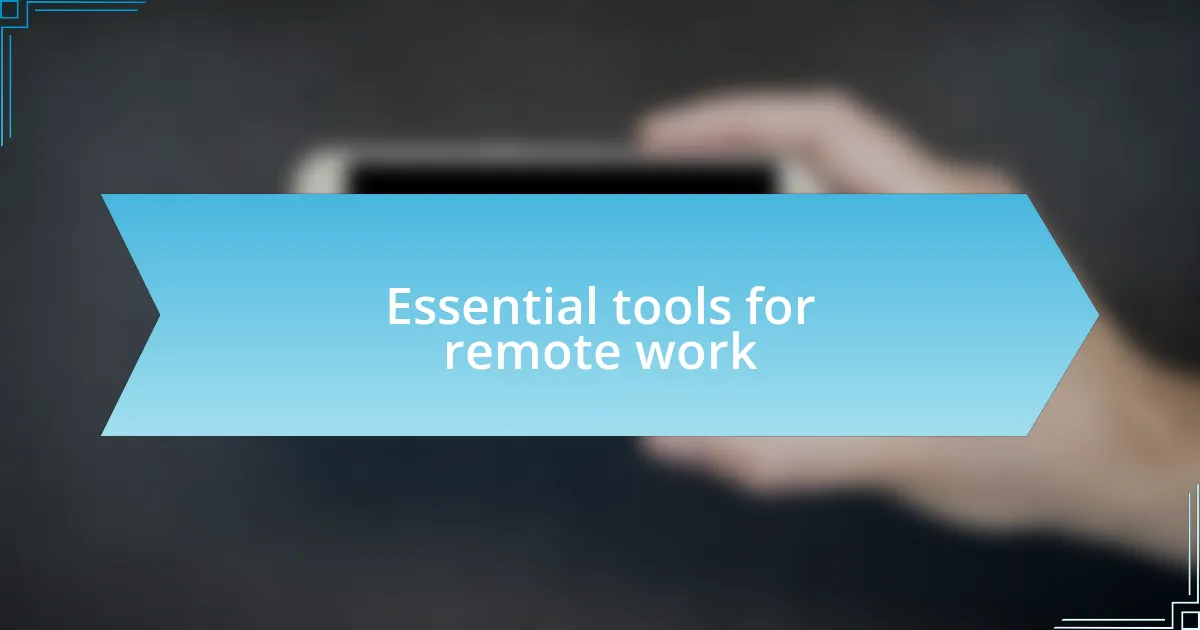
Essential tools for remote work
When it comes to remote work, having the right tools can make all the difference. I often think back to the early days of my remote journey, where I relied heavily on a handful of essential tools that streamlined my workflow and kept me connected. Without them, I’d probably still be grappling with miscommunication and chaotic task management.
Here’s a list of the essential tools that consistently enhance my remote work experience:
- Video Conferencing Software (like Zoom or Microsoft Teams): Crucial for face-to-face interactions, bridging the gap of distance, and fostering genuine connections.
- Project Management Platforms (such as Trello or Asana): They keep me organized and allow me to track progress alongside my team, reducing the feeling of isolation.
- Communication Apps (like Slack): These enable instant messaging, making conversations quicker and easier, and helping to maintain a friendly team dynamic.
- Cloud Storage Services (like Google Drive): Essential for storing and sharing important documents, ensuring everyone has access no matter where they are.
- Time Management Tools (for instance, Toggl): They help me understand how I allocate my time, which is vital in balancing work and personal life effectively.
By embracing these tools, I’ve been able to transform challenges into streamlined processes, making my remote work life not just bearable, but genuinely rewarding.
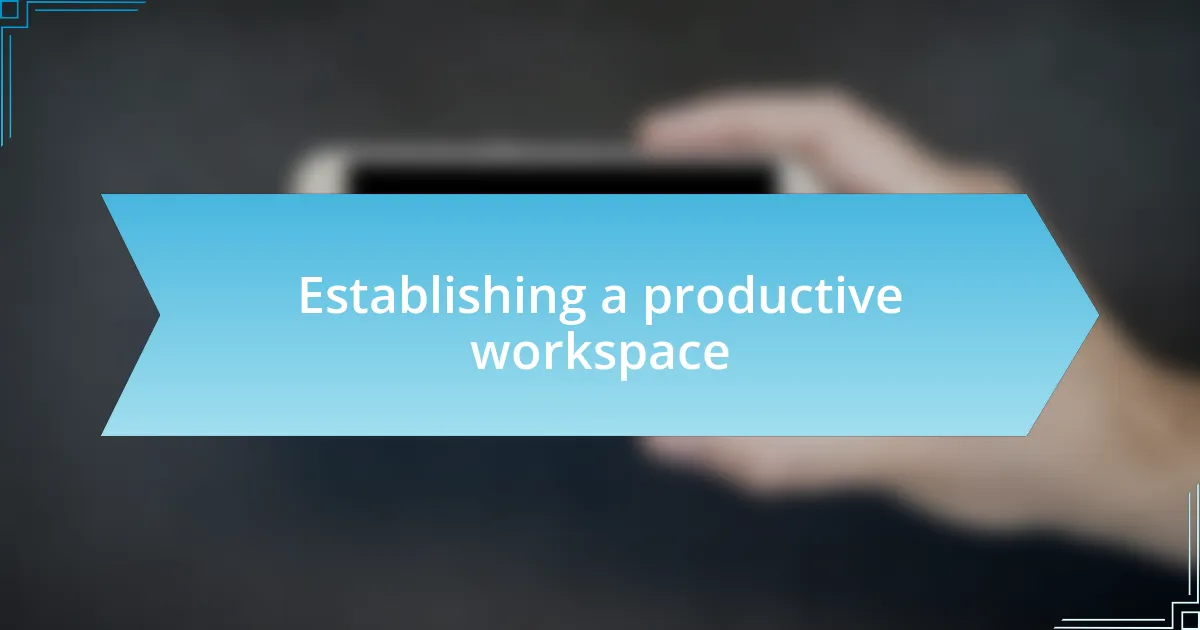
Establishing a productive workspace
Establishing a dedicated workspace is one of the first steps I took towards enhancing my productivity while working remotely. When I carved out a specific area in my home, it felt like I was creating a personal office space. The minute I sat down at my desk, the atmosphere shifted; I was no longer in my living room but had entered a zone focused solely on work.
Another key aspect of my workspace setup has been minimizing distractions. I remember those initial days of remote work when the temptation to lounge on the couch was all too real. I quickly learned that setting boundaries, both physically and mentally, was essential. I now make it a point to keep my workspace clutter-free, which helps me stay focused and improves my overall mental clarity.
Lighting also plays a critical role in my productivity. I’ve experimented with both natural light and adjustable lamps to find what works best for me. Natural light energizes me, and I often catch myself feeling more alive and creative on those sunny days. In contrast, when it was too dark, I noticed my energy levels dropped significantly. Each adjustment I’ve made has contributed positively to my productivity, allowing me to perform at my best.
| Aspect | Reflection |
|---|---|
| Space Design | Personal office feel boosts focus. |
| Distraction Management | Clutter-free zones enhance mental clarity. |
| Lighting | Natural light improves energy and creativity. |
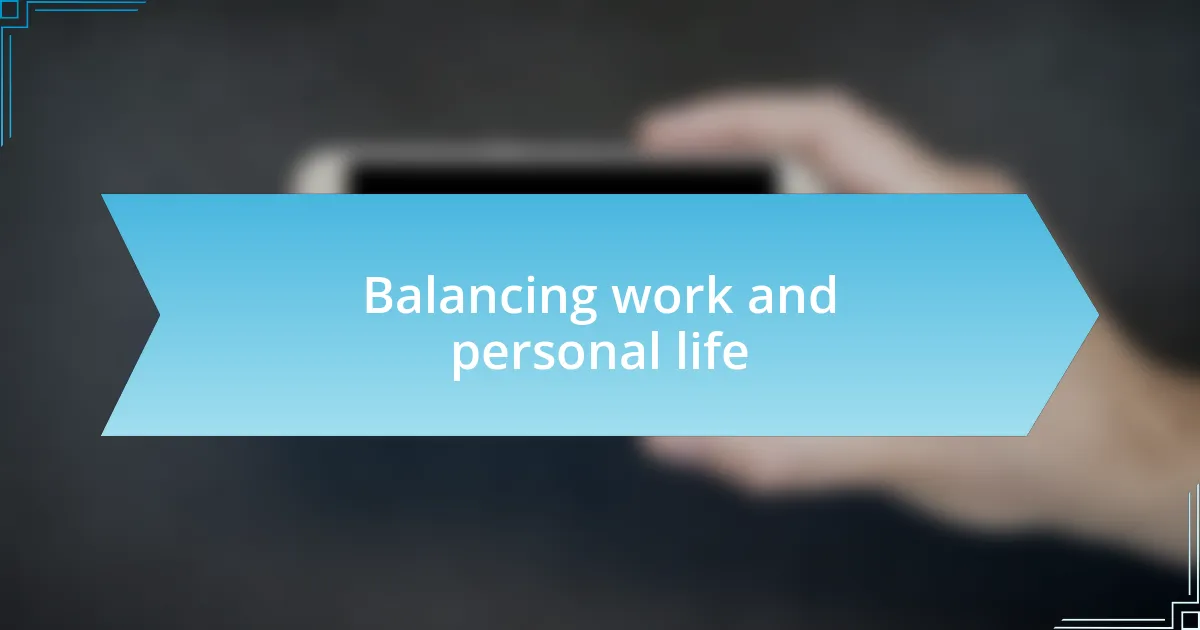
Balancing work and personal life
Finding a balance between work and personal life while working remotely has been a journey for me. At first, the lines blurred; I’d often find myself responding to emails late into the evening. I had to consciously set a quitting time each day, which became a fundamental game changer. Now, I simply ask myself, “When does my workday end, and when does my personal time begin?” Defining that boundary has freed up my evenings for family, hobbies, and self-care.
In my experience, planning daily activities is also vital for maintaining balance. Each week, I sit down and outline important tasks, but I always leave room for personal commitments. For instance, I might schedule a mid-afternoon break to take a walk or prepare a meal with loved ones. This approach ensures I stay productive during work hours while also cherishing those personal moments that rejuvenate me.
Additionally, I’ve leaned on technology to support my work-life harmony. Setting reminders to take breaks or dedicating time blocks for personal activities helps keep me mindful. It’s fascinating how something as simple as a calendar can act as a safeguard against burnout. Whenever I feel overwhelmed, I remind myself of the importance of these breaks; they not only recharge my energy but also fuel my creativity and focus when I return to work.
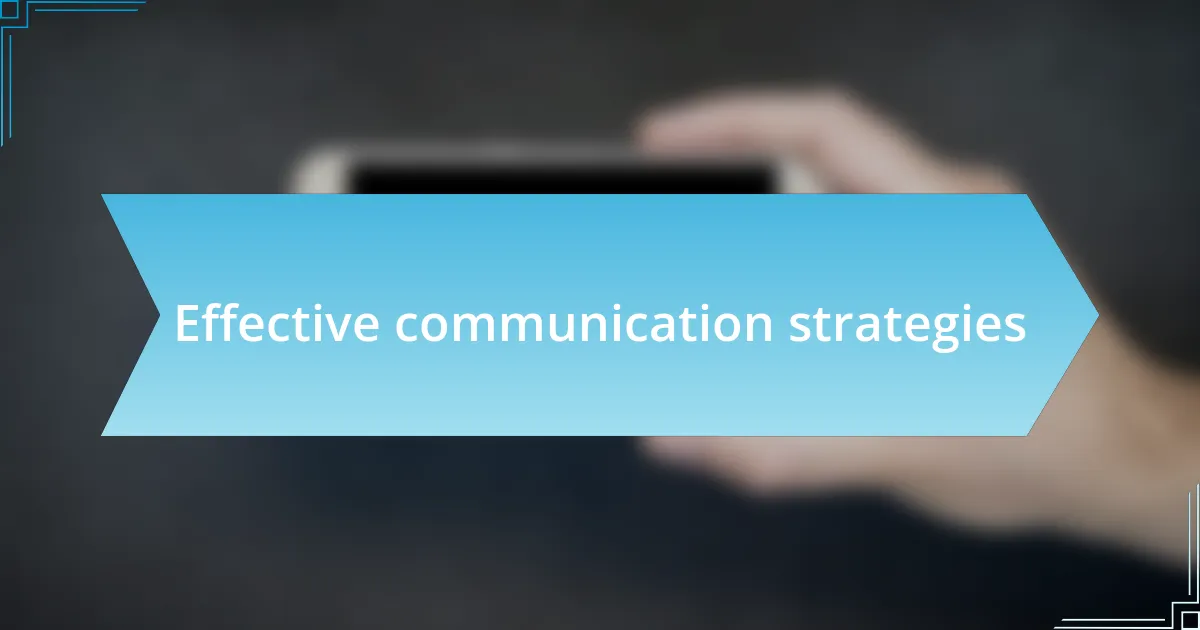
Effective communication strategies
Effective communication in a remote work setup can transform how we interact with colleagues. One strategy that worked wonders for me was the regular use of check-in meetings. Initially, I was hesitant, thinking they would feel too formal or unnecessary, but I quickly realized that these brief gatherings fostered connection and clarity. Every week, I set aside a few minutes to touch base with team members, asking questions like, “What challenges are you facing?” or “How can I support you?” These conversations have become a cornerstone of my remote work experience, allowing us to stay aligned and engaged.
Moreover, embracing various communication tools has enhanced my effectiveness. I found that mixing synchronous and asynchronous methods—like using instant messaging for quick updates and video calls for in-depth discussions—creates a more dynamic communication landscape. I vividly remember a moment when a quick chat via messaging resolved a potential misunderstanding that could have escalated into a larger issue. This flexibility allows me to choose the best mode of communication based on the situation, which ultimately leads to smoother collaboration.
Lastly, I’ve learned the importance of being transparent and approachable. When I share my thoughts openly, it encourages others to do the same. I often ask for feedback on my communication style or project updates to make sure everyone feels included and valued. I believe this openness cultivates trust within the team. Have you ever felt hesitant to voice your opinions? Realizing that these discussions can lead to innovation has reshaped how I view communication. Each channel we use, whether e-mail or a messaging app, should serve the purpose of forging stronger connections among us.
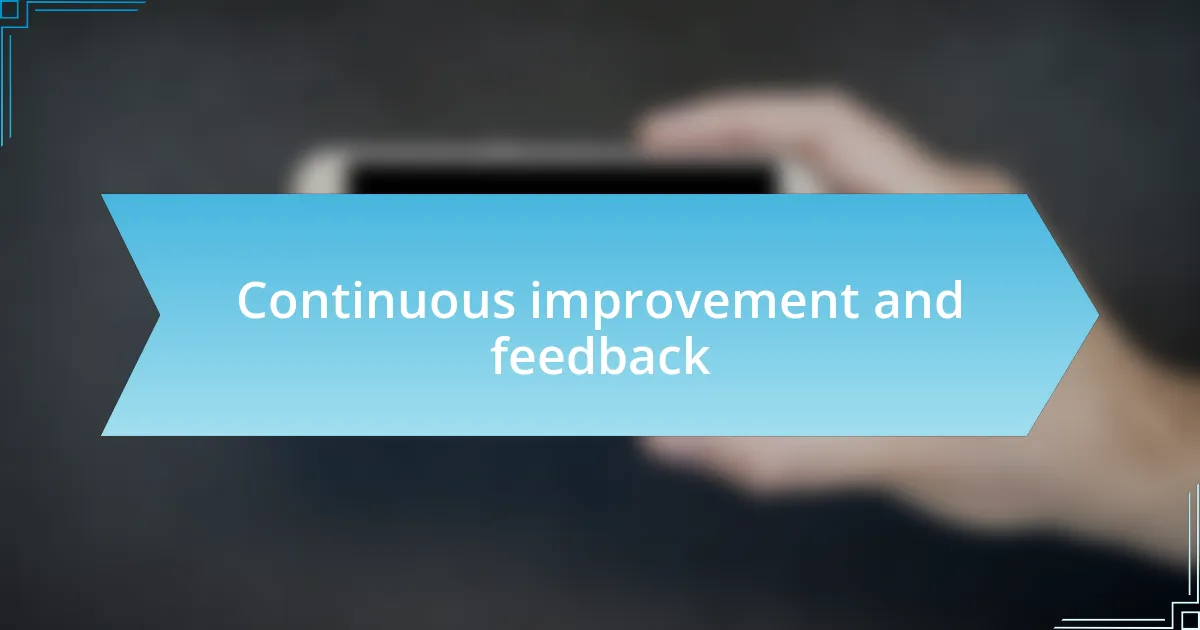
Continuous improvement and feedback
Continuous improvement and feedback are essential in the remote work landscape. I remember when I first started working remotely; I was uncertain about seeking feedback proactively. One day, I decided to ask a colleague for input on a project I was passionate about. Their constructive criticism helped me refine my ideas, and the experience made me realize just how valuable feedback can be. Have you ever hesitated to ask for feedback? Trust me, it can lead to personal growth and stronger collaborations.
As part of my commitment to continuous improvement, I’ve embraced a habit of self-reflection after each project. I ask myself questions like, “What went well?” and “What could I have done differently?” This practice has allowed me to pinpoint specific areas for growth. I recall a project where I felt overwhelmed by deadlines; evaluating my time management revealed that I had underestimated the complexity of the tasks. This insight led me to adjust my planning approach, resulting in smoother project execution in the future.
Another aspect of improvement that I find beneficial is creating a feedback loop with my team. By initiating regular feedback sessions, we can share experiences and insights without judgment. I remember one such session where a junior team member shared an innovative idea that completely changed the direction of our work. It was a wonderful reminder that every voice matters, and fostering an environment where feedback is encouraged can lead to remarkable breakthroughs we might otherwise miss. Isn’t it exciting to witness how collective input can elevate our work?
















